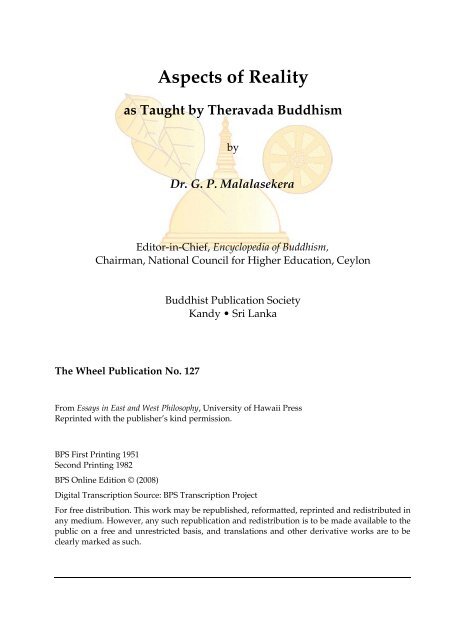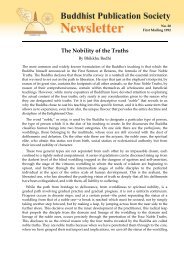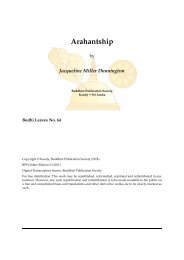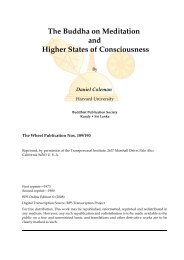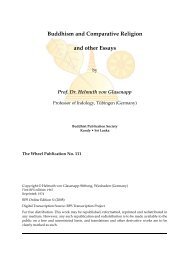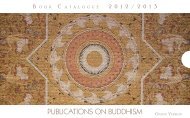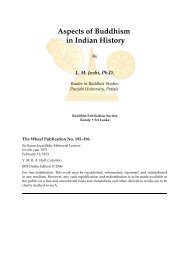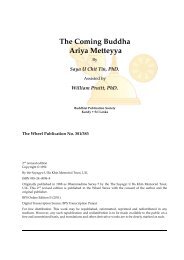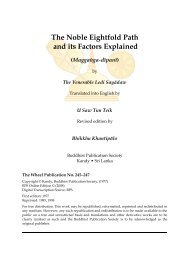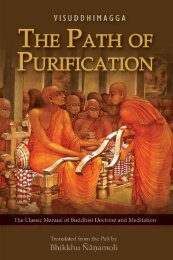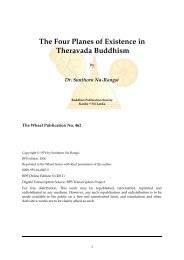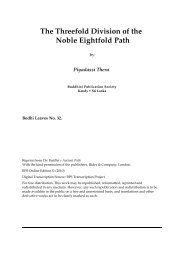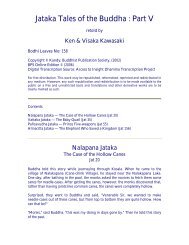Aspects of Reality as Taught by Theravada Buddhism - Buddhist ...
Aspects of Reality as Taught by Theravada Buddhism - Buddhist ...
Aspects of Reality as Taught by Theravada Buddhism - Buddhist ...
You also want an ePaper? Increase the reach of your titles
YUMPU automatically turns print PDFs into web optimized ePapers that Google loves.
<strong>Aspects</strong> <strong>of</strong> <strong>Reality</strong><br />
<strong>as</strong> <strong>Taught</strong> <strong>by</strong> <strong>Theravada</strong> <strong>Buddhism</strong><br />
<strong>by</strong><br />
Dr. G. P. Malal<strong>as</strong>ekera<br />
Editor-in-Chief, Encyclopedia <strong>of</strong> <strong>Buddhism</strong>,<br />
Chairman, National Council for Higher Education, Ceylon<br />
<strong>Buddhist</strong> Publication Society<br />
Kandy • Sri Lanka<br />
The Wheel Publication No. 127<br />
From Essays in E<strong>as</strong>t and West Philosophy, University <strong>of</strong> Hawaii Press<br />
Reprinted with the publisher’s kind permission.<br />
BPS First Printing 1951<br />
Second Printing 1982<br />
BPS Online Edition © (2008)<br />
Digital Transcription Source: BPS Transcription Project<br />
For free distribution. This work may be republished, reformatted, reprinted and redistributed in<br />
any medium. However, any such republication and redistribution is to be made available to the<br />
public on a free and unrestricted b<strong>as</strong>is, and translations and other derivative works are to be<br />
clearly marked <strong>as</strong> such.
<strong>Aspects</strong> <strong>of</strong> <strong>Reality</strong> <strong>as</strong> <strong>Taught</strong> <strong>by</strong> <strong>Theravada</strong> <strong>Buddhism</strong><br />
In regard to the question “What is ultimate reality” the different schools <strong>of</strong> philosophy or<br />
systems <strong>of</strong> thought seem to fall into two main divisions. Some <strong>of</strong> them say that the ultimate<br />
reality is one: they believe in a permanent unity behind all the variety and change <strong>of</strong> the world.<br />
They are the monists, theists, animists, eternalists, traditionalists, fideists, dogmatists,<br />
ontologists, realists, idealists, and energists. All these schools, though distinct among<br />
themselves and even opposed to each other on many points, nevertheless have this in common:<br />
they accept an ultimate reality <strong>as</strong> an entity in the metaphysical sense, whether that entity be<br />
called substance, or soul, or God, or force, or categorical necessity, or whatever other name may<br />
yet be invented. They may be said to follow a subjective method, molding reality on concepts.<br />
Hence theirs is mostly a method <strong>of</strong> conjecture. The other schools say, some <strong>of</strong> them not very<br />
explicitly but still implicitly in their doctrines, that the ultimate reality is plural. They follow an<br />
objective method, molding their conceptions on observations. They generally deny a unity<br />
behind or within nature’s plurality. These are the dualists, pluralists, atheists, nominalists,<br />
relativists, rationalists, positivists, phenomenalists, annihilationists, occ<strong>as</strong>ionialists,<br />
transformists, progressivists, materialists, and so on. Here again, all these schools, though<br />
differing among themselves on many points, have this in common: they reject a metaphysical<br />
entity.<br />
Now, what is the place <strong>of</strong> <strong>Buddhism</strong> among these different “isms” The answer is that it does<br />
not belong to either group. The ultimate reality <strong>of</strong> the phenomena in the universe (the chief<br />
phenomenon around which all others centre) being the “I,” the self, is, according to <strong>Buddhism</strong>,<br />
neither plural, nor one, but none. In religion and philosophy, <strong>as</strong> well <strong>as</strong> in metaphysics, the<br />
words “real” and “reality” express more than one <strong>as</strong>pect <strong>of</strong> things: the actual <strong>as</strong> opposed to the<br />
fictitious; the essential <strong>as</strong> opposed to the accidental; the absolute or unconditioned <strong>as</strong> opposed to<br />
the relative or conditioned; the objectively valid <strong>as</strong> opposed to the ideal or the imagined; that<br />
which ultimately and irreducibly is opposed to that which <strong>by</strong> means <strong>of</strong> various names signifies<br />
the mind’s stock <strong>of</strong> knowledge. It must be admitted that in the sutt<strong>as</strong>, or discourses, attributed<br />
to the Buddha we do not find any terms exactly corresponding to “real” and “reality,” but all<br />
the above antitheses do occur and find expression in a variety <strong>of</strong> ways. The Buddha’s teachings<br />
are more deeply and directly concerned with truth and the pragmatic importance <strong>of</strong> things,<br />
more with what might be called “spiritual health” than with theories. There are certain facts<br />
regarding spiritual health, however, about which it is necessary to have right views in order that<br />
action may be taken accordingly. These are the actualities; other things are <strong>of</strong> very much less<br />
value. The true is, therefore, the actual, that which is. It is expressed <strong>by</strong> the Pali word sacca<br />
(Sanskrit, satya), which means “the fact” or “the existent.”<br />
It must always be borne in mind that <strong>Buddhism</strong> is primarily a way <strong>of</strong> life and, therefore, that<br />
it is with the human personality that it is almost wholly concerned. Various metaphors are used<br />
to describe the essential nature <strong>of</strong> the personality. 1 They are meant not so much to indicate the<br />
ontological unreality <strong>of</strong> objects and sense impressions (like the māya, or illusion, which we come<br />
across in the Vedānta) <strong>as</strong> to express a repudiation <strong>of</strong> permanence, a sense <strong>of</strong> happy security, a<br />
superphenomenal substance or soul underlying them. They are also meant <strong>as</strong> a deprecation <strong>of</strong><br />
any genuine, satisfying value in spiritual life to be found either in “the pride <strong>of</strong> life” or in the<br />
lust <strong>of</strong> the world.<br />
1<br />
E. g., “To regard the body <strong>as</strong> something <strong>of</strong> worth would be like taking frescoes to be real persons.” Or<br />
again, “As one would view a bubble, <strong>as</strong> one would view a mirage, so should the world be looked at.”<br />
(Dhammapada verse 170.) “The world is like a dream.” (Saṃyutta Nikāya, S III 141)<br />
2
At the time <strong>of</strong> the Buddha there were in India views similar both to those <strong>of</strong> the Parmenidean<br />
school <strong>of</strong> Greater Greece (that the universe is a plenum <strong>of</strong> fixed, permanent existents) and to<br />
that other extreme field <strong>by</strong> Gorgi<strong>as</strong> and the Sophists (that nothing is). In all things the Buddha’s<br />
teachings represent what he terms the Middle Way (majjhima paṭipadā), the doctrine <strong>of</strong> the<br />
golden mean, the theory <strong>of</strong> conditioned or c<strong>as</strong>ual becoming, the most succinct statement <strong>of</strong><br />
which is to be found in the Saṃyutta-Nikāya: “’Everything is’: this, Oh Kaccāyana, [is the first]<br />
extreme. ’Everything is not’: this, is the second extreme.” 2 The Tathāgata (that being the term<br />
which the Buddha used when speaking <strong>of</strong> himself), not accepting these two extremes, preaches<br />
his doctrine <strong>of</strong> the Middle Way.<br />
The followers <strong>of</strong> the first extreme were known to the Buddha <strong>as</strong> eternalists (s<strong>as</strong>satavādino).<br />
Some <strong>of</strong> them stuck to the old sacrificial religion which promised blissful existence in heaven<br />
after death. Others favoured a monistic view <strong>of</strong> the universe and believed in the attainment <strong>of</strong> a<br />
supreme bliss which consisted in the dissolution <strong>of</strong> personality in an impersonal, all-embracing<br />
Absolute. There were others who held the idea <strong>of</strong> an eternal, individual soul, which, after many<br />
existences, would return to its genuine condition <strong>of</strong> free spirit <strong>as</strong> a result <strong>of</strong> accumulated merit.<br />
These various views are described in the Brahmajāla Sutta <strong>of</strong> the Dīgha-Nikāya. 3 It is interesting<br />
to note from these descriptions that the various schools <strong>of</strong> idealism, which later appeared in the<br />
West, had their counterparts in the India <strong>of</strong> the Buddha, e. g., subjective idealism (which holds<br />
that it is the “I” alone which exists, all the rest being a modification <strong>of</strong> my mind), objective<br />
idealism (which holds that all, including the “I,” are mere manifestations <strong>of</strong> the Absolute), or the<br />
absolute idealism <strong>of</strong> Hegel (which informs us that only the relation between the subject and<br />
object is real). All these varieties <strong>of</strong> idealism the Buddha held to be “painful, ignoble, and<br />
leading to no good, because <strong>of</strong> their being intent upon self-mortification.” 4 Idealism, according<br />
the Buddha, h<strong>as</strong> but one reality, that <strong>of</strong> thought, and strives for but one end, the liberation <strong>of</strong> the<br />
thinking self. Addiction to self-mortification is merely the practical side <strong>of</strong> the speculations <strong>of</strong><br />
idealism, in which the “self” is sublimated, with the natural consequence that the “self” must be<br />
liberated from matter, the “soul” must be freed from the bonds <strong>of</strong> the body. The p<strong>as</strong>sions <strong>of</strong> the<br />
body must be subdued even <strong>by</strong> force. Body becomes the eternal enemy <strong>of</strong> the spirit, to be<br />
overcome <strong>by</strong> prayer, f<strong>as</strong>ting and other austerities.<br />
The followers <strong>of</strong> the second extreme, who denied any survival <strong>of</strong> the individual after death or<br />
any retribution for moral and immoral deeds, the Buddha called annihilationists (ucchedavādin).<br />
The annihilationists, too (or, <strong>as</strong> they came to be called later, the materialists), had many varieties<br />
<strong>of</strong> belief in ancient India. Some, like the Epicureans, denied any external Agency <strong>as</strong> the cause <strong>of</strong><br />
matter and maintained that the highest good w<strong>as</strong> ple<strong>as</strong>ure. Others, very much in the manner <strong>of</strong><br />
Hobbes, Comte, or John Stuart Mill, held that only the sensuous could be an object <strong>of</strong><br />
knowledge. But all <strong>of</strong> them saw only one origin, matter, and strove only for one end, material<br />
well-being. Incre<strong>as</strong>e <strong>of</strong> comfort, said the Buddha, only leads to desire for still more, and the<br />
desire for more leads, and will always lead, to conflict and conquest. He, therefore, condemned<br />
materialism <strong>as</strong> “despicable, vulgar, ordinary, b<strong>as</strong>e, and leading to no good. 5<br />
In the Buddha’s view, both idealism and materialism, though theoretically opposed, converge<br />
both in their starting-point and in their goal, for “self is their beginning and satisfaction their<br />
end.” Between these two extremes, therefore, <strong>of</strong> materialistic self-indulgence and idealistic self-<br />
2<br />
Saṃyutta Nikāya, S II 17. See Mrs. Rhys Davids trans., in F. L. Woodward, Kindred Sayings (London:<br />
Oxford University Press 1926), Vol. IV, p. 13.<br />
3<br />
The first discourse <strong>of</strong> the Dīgha Nikāya. See T. W. Rhys Davids, trans., Dialogues <strong>of</strong> the Buddha<br />
(London: Oxford University Press, 1901), Vol. I.<br />
4<br />
Saṃyutta Nikāya, S IV 330f. Dhammacakkapavattana Sutta. See Lord Chalmers, trans. Further Dialogues <strong>of</strong><br />
the Buddha (London: Oxford University Press 1926).<br />
5<br />
Ibid.<br />
3
denial (not <strong>as</strong> a comprise, but, “avoiding both”), the Buddha formulated the Middle Way, “the<br />
way <strong>of</strong> knowledge and wisdom,” not in the wavering <strong>of</strong> speculation, or in the excitement <strong>of</strong><br />
discussion, but “in tranquillity <strong>of</strong> mind and penetrative insight, leading to enlightenment and<br />
deliverance, enlightenment with regard to the real nature <strong>of</strong> things and deliverance from<br />
suffering and its cause.” 6<br />
In following the middle course the Buddha borrowed from the eternalists their doctrine <strong>of</strong> the<br />
gradual accumulation <strong>of</strong> spiritual merit in a series <strong>of</strong> existences, but rejected their doctrine <strong>of</strong> an<br />
eternal spiritual principle. He saw contradiction in <strong>as</strong>suming an eternal, pure, spiritual principle<br />
which for incomprehensible re<strong>as</strong>ons became polluted with the filth <strong>of</strong> mundane existence only<br />
to revert later to original purity. With the annihilationists he denied every permanent principle.<br />
The Buddha’s originality consisted in denying substantiality altogether and converting the<br />
world process into a progression <strong>of</strong> discrete, evanescent elements. His position w<strong>as</strong> not an e<strong>as</strong>y<br />
one because he had also to find a theoretical b<strong>as</strong>is to establish morality. He w<strong>as</strong> faced with the<br />
contradiction <strong>of</strong> a moral law without a personality on whom the law w<strong>as</strong> binding, salvation<br />
with nobody to reach the goal. How he solved the problem will appear in the sequel. The<br />
shortest statement <strong>of</strong> the Buddha’s doctrine is contained in a formula which h<strong>as</strong> come to be<br />
regarded <strong>as</strong> the <strong>Buddhist</strong> credo: “Whatsoever things proceed from a cause, the Tathāgata [i.e.<br />
the Buddha] h<strong>as</strong> declared the cause there<strong>of</strong>; he h<strong>as</strong> explained their cessation also.” This is the<br />
doctrine <strong>of</strong> the recluse. It declares, in other words, that the Buddha h<strong>as</strong> discovered the elements<br />
and their c<strong>as</strong>ual connection, and a method to suppress forever their active efficiency and secure<br />
their quiescence.<br />
The Buddha claimed that his w<strong>as</strong> a practical teaching: its object w<strong>as</strong> to show a way <strong>of</strong> escape<br />
from the ever-revolving round <strong>of</strong> birth-and-death, which constitutes saṃsāra and which is<br />
considered a condition <strong>of</strong> degradation and suffering (dukkha). This way <strong>of</strong> escape w<strong>as</strong> meant<br />
primarily for human beings. True to this central conception, therefore, <strong>as</strong> stated above, the<br />
Buddha started with a minute analysis (using “analysis” in its strictest sense <strong>of</strong> “dissolution”) <strong>of</strong><br />
the human being into the elements <strong>of</strong> which his being is composed. Analysis h<strong>as</strong> always played<br />
a very important part in <strong>Buddhist</strong> teaching; in fact, one <strong>of</strong> its names is the doctrine <strong>of</strong> analysis<br />
(vibhajjavāda).<br />
In this analysis, the human being w<strong>as</strong> found to consist <strong>of</strong> two parts, nāma and rūpa,, (loosely<br />
translated <strong>as</strong> mind and matter), rūpa representing the physical elements and nāma the mental<br />
ones. Matter is composed <strong>of</strong> the four elementary qualities <strong>of</strong> extension, cohesion, caloricity (tejo),<br />
and vibration. The relative qualities <strong>of</strong> hardness and s<strong>of</strong>tness and the occupation <strong>of</strong> space are<br />
due to the elementary quality <strong>of</strong> extension (paṭhavī). It is the element <strong>of</strong> cohesion (āpo) which<br />
makes the many parts adhere intrinsically and to one another, and this prevents an aimless<br />
scattering about or disintegration, thus giving rise to the idea <strong>of</strong> a “body.” Caloricity depends on<br />
vibration (vayo), for <strong>by</strong> incre<strong>as</strong>ed vibration the temperature rises and when the temperature is<br />
lowered the speed <strong>of</strong> vibration is reduced. Thus do g<strong>as</strong>es liquify and solids solidify. 7 The mental<br />
elements are similarly divided into four groups: feelings or “receptions” (vedanā), ide<strong>as</strong> or<br />
“perceptions” (saññā), what is variously translated <strong>as</strong> “mental activities” or “complexes”<br />
(saṅkhāra), 8 and cognition or “conception” (viññāṇa). Rūpa (matter), and these four mental<br />
groups are called khandha (aggregates or groups). The whole, in brief, is an analysis <strong>of</strong> the “I” or<br />
“personality” (sakkāya). The apparently unitary “I” is broken up into a number <strong>of</strong> layers, <strong>as</strong> in a<br />
6<br />
Ibid.<br />
7<br />
For a very good exposition <strong>of</strong> this and what follows, see Th. Stcherbatsky, The Central Conception <strong>of</strong><br />
<strong>Buddhism</strong> (London: Royal Asiatic Society, 1923).<br />
8<br />
Saṅkhāra is a very difficult term to translate, since it means various things in various contexts.<br />
Etymologically, it means “what is put together <strong>as</strong> a composite thing.” See T. W. Rhys David and W. Stede,<br />
Pali-English Dictionary Pali Text Society), s. v.<br />
4
urning flame a number <strong>of</strong> layers <strong>of</strong> colour can be distinguished. But the layers <strong>of</strong> colour in a<br />
flame are not parts laid out after the f<strong>as</strong>hion <strong>of</strong> pieces in mosaic, alongside one another. So also<br />
is it with the five khandha or groups. They are a continuous, unbroken process <strong>of</strong> action, <strong>of</strong><br />
which it is expressly said that they are “burning.”<br />
In all <strong>of</strong> them an arising and a p<strong>as</strong>sing away are to be cognized. They are not parts <strong>of</strong> a whole<br />
but forms <strong>of</strong> action, a process <strong>of</strong> mental-corporeal “nutrition” or “sustenance,” in which the<br />
corporeal <strong>as</strong> well <strong>as</strong> the mental forms <strong>of</strong> gr<strong>as</strong>ping (upādāna) 9 fall together into one conceptual<br />
unity. They are different modes in which the “I” enters into relation with the external world,<br />
lays hold <strong>of</strong> it, “seizes” it. The relationship is not an immediate relation with the external world<br />
in which a metaphysical “I” is endowed a priori with the power <strong>of</strong> cognizing, nor is it the<br />
mediate relation <strong>of</strong> a purely physical process in which the “I” only builds itself up a posteriori on<br />
the b<strong>as</strong>is <strong>of</strong> continued experiences.<br />
The external world with which the human being comes into relationship is also analyzed into<br />
its component elements. This relationship is one <strong>of</strong> cognition, and in discussing how this<br />
cognition is established mention is made <strong>of</strong> cognitive faculties (indriya) and their objects (visaya).<br />
There are thus six cognitive faculties or senses: the senses <strong>of</strong> vision, audition, smell, t<strong>as</strong>te, touch,<br />
and the faculty <strong>of</strong> intellect or consciousness. 10<br />
Corresponding to these <strong>as</strong> objects <strong>of</strong> cognition are, respectively, colour and shape, sound,<br />
odour, savours, tangibles, and non-sensuous objects. These twelve factors (the cognitive<br />
faculties and their objects) are called āyatanāni, or b<strong>as</strong>es <strong>of</strong> cognition. The term āyatana means<br />
place, sphere, entrance, or point <strong>of</strong> support, and is used to cover both organ <strong>of</strong> sense (internal or<br />
ajjhattāni āyatanāni) and sense object (external or bāhirāni āyatanāni), the meeting <strong>of</strong> which<br />
constitutes cognition (viññāṇa). This cognition, which results from the meeting, can be divided<br />
into six cl<strong>as</strong>ses, according to the cognitive faculty concerned and the sense object, such <strong>as</strong> eyecognition<br />
(cakkhuviññāṇa), and so on.<br />
In the c<strong>as</strong>e <strong>of</strong> the sixth cognitive faculty (man<strong>as</strong>), consciousness itself (i.e., its preceding<br />
moment) acts <strong>as</strong> a faculty for apprehending non-sensuous objects. The three constituents that<br />
comprise a cognition, sense faculty, sense object, and resultant consciousness, are cl<strong>as</strong>sified<br />
under the name dhātu (element). We thus get eighteen dhātu: the six sense faculties, their six<br />
sense objects and the six varieties <strong>of</strong> resultant consciousness. This consciousness is the<br />
experience <strong>of</strong> the unity between concept and object; it is not something that is, but something<br />
that becomes. It is not an object <strong>of</strong> knowing, but knowing itself, an ever-repeated new becoming,<br />
new up-springing out <strong>of</strong> its antecedent conditions. As such it resembles what the physicist calls<br />
living-force, vital energy. It is formed, enfleshed, in nāma-rūpa, (mind-form, i. e., mind and<br />
body). Mind-form is the antecedent condition <strong>of</strong> consciousness, on the b<strong>as</strong>is <strong>of</strong> which the next<br />
new up-springing <strong>of</strong> consciousness will <strong>as</strong>sume new individual value.<br />
Consciousness is actuality <strong>as</strong> action, which means something that is not but which, in order to<br />
be present, first must ever spring up anew. Between mind-form and consciousness exists the<br />
same ce<strong>as</strong>eless, quivering, leaping play which exists among the ever-repeated, new moments <strong>of</strong><br />
combustion <strong>of</strong> a flame and its external shape. Without sufficient cause (aññatra paccaya) no<br />
consciousness can arise. 11 Just <strong>as</strong> for consciousness to be present, it must ever and again spring<br />
up anew, similarly the antecedent conditions upon the b<strong>as</strong>is <strong>of</strong> which it springs up must also be<br />
present. It is from the friction <strong>of</strong> the living contact <strong>of</strong> senses with things that consciousness is<br />
9<br />
“Form, O monks, is burning” (rūpaṃ bhikkhave ādittaṃ) and so on with the other khandha.” Saṃyutta<br />
Nikāya, S IV 21. See F. L. Woodward, Kindred Sayings (London: Oxford University Press. 1927), Vol. IV.<br />
10<br />
For an excellent exposition <strong>of</strong> this point, see Paul Dahlke’s <strong>Buddhism</strong> (London: The Macmillan<br />
Company, 1927), pp. 129 ff.<br />
11<br />
See the Majjhima Nikāya Sutta No. 38, Mahātaṇhāsaṅkhaya Sutta.<br />
5
orn. It is thus a process <strong>of</strong> nutrition, <strong>of</strong> gr<strong>as</strong>ping, which embraces itself in its gr<strong>as</strong>ping, a<br />
process <strong>of</strong> growth, in which one moment is neither the same <strong>as</strong> the next, nor yet another, but in<br />
which every moment becomes another, p<strong>as</strong>ses into that other, just <strong>as</strong> one moment <strong>of</strong> a flame is<br />
neither the same <strong>as</strong> the next, nor yet another, but becomes the next.<br />
The human personality, and the external world with which it enters into relationship, are<br />
thus divided into khandha, āyatana and dhātu. The generic name for all three <strong>of</strong> them is dhamma<br />
(plural dhamma), which is translated <strong>as</strong> “element <strong>of</strong> existence.” In <strong>Buddhism</strong> these dhamma<br />
are the only ultimate reality. Broadly speaking, the dhamma are divided into two cl<strong>as</strong>ses,<br />
saṅkhata (conditioned, i.e., subject to various conditions) and <strong>as</strong>aṅkhata (unconditioned).<br />
According to <strong>Theravada</strong>, Nibbāna is the only <strong>as</strong>aṅkhata-dhamma: all other dhamma are saṅkhata<br />
(conditioned). The saṅkhata (conditioned dhamma) have four salient characteristics: they are nonsubstantial<br />
(anattā), evanescent (anicca), in a beginningless state <strong>of</strong> commotion (dukkha), and<br />
have quiescence only in a final cessation (nirodha).<br />
It must always be recalled that the b<strong>as</strong>ic idea <strong>of</strong> this analysis is a moral one. <strong>Buddhism</strong> is<br />
defined <strong>as</strong> a religion which teaches defilement and its purification (saṅkilesa and vodāna).<br />
Purification or salvation lies in nibbāna or nirodha, which is cessation from saṃsāra. Thus, when<br />
the elements <strong>of</strong> being are analyzed, they are divided into purifying and defiling elements, good<br />
and bad (sāsava and anāsava), propitious to salvation and averse to it (kusala and akusala).<br />
Purifying, good, and propitious factors are those elements, those moral factors, that lead to<br />
Nibbāna; their opposites lead to or encourage saṃsāra.<br />
This analysis w<strong>as</strong> part <strong>of</strong> the Buddha’s attempt to find answers to the great, primary<br />
questions which lie at the bottom <strong>of</strong> every religious system, which form the seed <strong>of</strong> religious<br />
development. Upon these answers depend the nature <strong>of</strong> any religious philosophy, viz. Whence<br />
am I Whither do I go What happens to me after death How do I know myself How does this<br />
world enter into me, into my consciousness To the Buddha’s way <strong>of</strong> thinking, all these<br />
questions have one great fallacy, that <strong>of</strong> begging the question, petitio principii. His view w<strong>as</strong> that<br />
there should be another question prior to all these inquiries, upon which depends the very<br />
possibility <strong>of</strong> further questioning, namely: Is there anything at all which deserves the<br />
designation “I” Here w<strong>as</strong> a problem which the Buddha felt could not be solved <strong>by</strong> argument or<br />
mere logic (atakkāvacara), for in logic, one h<strong>as</strong> to presuppose the reality <strong>of</strong> the thinking subject <strong>as</strong><br />
standing outside the process <strong>of</strong> thinking, <strong>as</strong> a witness or, rather, <strong>as</strong> a judge. Only one kind <strong>of</strong><br />
logic, he said, could help here: the logic <strong>of</strong> events, because it is beyond sophistry. Actuality can<br />
be understood not <strong>by</strong> argument but <strong>by</strong> analysis (yoniso man<strong>as</strong>ikāra). 12<br />
As a result <strong>of</strong> such analysis, the Buddha discovered that the individual, conventionally called<br />
“I” or the “self,” is a m<strong>as</strong>s <strong>of</strong> physical and psychical elements without any permanent entity<br />
behind them to keep them together, without any “soul” inhering in them, the elements<br />
themselves being a mere flux (santāna), a continuity <strong>of</strong> changes. In postulating a mythical,<br />
unchanging entity <strong>as</strong> the possessor <strong>of</strong> changing qualities, one merely <strong>as</strong>sumes, he said, the<br />
existence <strong>of</strong> that which h<strong>as</strong> to be proved. The conviction that men hold that, though thought and<br />
actions change, the thinker and the doer remain the same, w<strong>as</strong> a delusion, for it is exactly <strong>by</strong><br />
thought that we change our minds, <strong>by</strong> actions that we change our lives. Actions cannot exist<br />
apart from the doer, cannot exist freely <strong>as</strong> such. If the action changes, the so called actor must<br />
change at the same instant. Thus, the “I” must be identified with action. It is only the “I” which<br />
can walk and sit and think and eat and sleep. But that “I” is not a permanent, unchanging entity;<br />
it is identified with the action and is the action itself, and thus changes with the action. “I”<br />
cannot stay at home while “I” go out for a walk. It is the conventional language (sammuti) which<br />
h<strong>as</strong> spoiled the purity <strong>of</strong> conception (paramattha—ultimate sense, the supreme-thing-meant),<br />
12<br />
For an explanation <strong>of</strong> this very significant word, see Pali-English Dictionary, s.v.<br />
6
though, in some c<strong>as</strong>es, language does remain pure enough, <strong>as</strong> when we say, “It rains.” Who<br />
rains Simply, it rains, meaning, there is rain. Likewise, the concept should not be: “I think,” but<br />
“There is thinking.” This is the teaching which came to be known <strong>as</strong> the doctrine <strong>of</strong> anattā. In<br />
this doctrine, the Buddha went counter to the three main systems <strong>of</strong> philosophy that were<br />
current in India in his day: the teaching <strong>of</strong> the Upaniṣads, <strong>of</strong> the Sāṅkhya. Briefly stated, the<br />
Upaniṣadic teaching is a kind <strong>of</strong> monism, where a real being, Brahman, is <strong>as</strong>sumed to be<br />
something eternal, without beginning, change, or end, and man’s soul (ātman) is <strong>as</strong>sumed to be<br />
an integral part <strong>of</strong> that Being, Atman and Brahman being one. The Jains had a highly developed<br />
theory <strong>of</strong> moral defilement and purification and a theory <strong>of</strong> spiritual existence extending even to<br />
plants and inanimate, non-organic things, which are also supposed to possess souls. The<br />
saṅkhya taught the existence <strong>of</strong> a plurality <strong>of</strong> souls, on the one hand, and <strong>of</strong> a unique, eternal,<br />
perv<strong>as</strong>ive, substantial matter, on the other. <strong>Buddhism</strong> is opposed to all three systems. Forsaking<br />
the monism <strong>of</strong> the Upaniṣads, it declares that there is no real unity at all in the world.<br />
Everything is discrete, separate, split up into an infinity <strong>of</strong> minute, impermanent<br />
elements, without any abiding stuff. It agrees with Jainism in opposing the monism <strong>of</strong> the<br />
Upanisads and in maintaining that being is joined to production, continuation, and destruction,<br />
but disagrees with the Jain doctrine which <strong>as</strong>cribed to a kamma a physical nature. To the<br />
dualism <strong>of</strong> saṅkhaya the Buddha opposes the most radical pluralism, converting the world<br />
process into an appearance <strong>of</strong> evanescent elements, and calls the eternal perv<strong>as</strong>ive matter,<br />
which is imagined <strong>as</strong> their support or substratum, a mere fiction.<br />
The term anattā (Sanskrit, anātman) is usually translated <strong>as</strong> “no soul,” but, strictly speaking,<br />
atta is here synonymous only with a permanent, enduring entity, ego, self, conscious agent, etc.<br />
It is the permanence that is denied in anattā. The underlying idea is that, whatever may be<br />
designated <strong>by</strong> these names, it is not a real, ultimate fact; it is a mere name for a multitude <strong>of</strong><br />
interconnected facts which <strong>Buddhist</strong> philosophy attempts to analyze <strong>by</strong> reducing them to real<br />
elements (dhamma). <strong>Buddhism</strong> does not deny the existence <strong>of</strong> a personality or a “soul” in the<br />
empirical sense. What it does deny is that such a “soul” is an ultimate reality, a dhamma. The<br />
<strong>Buddhist</strong> teaching <strong>of</strong> anattā does not proclaim the absence <strong>of</strong> an individuality or self; it says<br />
only that there is no permanent individuality, no unchanging self.<br />
Personality or individuality is, according to <strong>Buddhism</strong>, not an entity but a process <strong>of</strong> arising<br />
and p<strong>as</strong>sing away, a process <strong>of</strong> nutrition, <strong>of</strong> combustion, <strong>of</strong> gr<strong>as</strong>ping. Man’s personality is<br />
conceded <strong>as</strong> being something real, a fact (sacca) to him at any given moment, though the word<br />
“personality” is only a popular label and does not correspond to any fixed entity in man. In the<br />
ultimate constituents <strong>of</strong> conditioned things, physical and mental, <strong>Buddhism</strong> h<strong>as</strong> never held that<br />
the real is necessarily the permanent. Unaware <strong>of</strong> this anticipation, modern philosophers like<br />
Bertrand Russell are <strong>as</strong>king modern philosophy to concede no less.<br />
The <strong>Buddhist</strong> term for an individual, a term which is intended to suggest the <strong>Buddhist</strong> view<br />
<strong>as</strong> opposed to other theories, is santāna (stream), viz. the stream <strong>of</strong> interconnected facts. It<br />
includes the mental elements <strong>as</strong> well <strong>as</strong> the physical, the elements (dhamma) <strong>of</strong> one’s own body<br />
and external objects, <strong>as</strong> far <strong>as</strong> they constitute the experience <strong>of</strong> a given personality.<br />
The representatives <strong>of</strong> the eighteen cl<strong>as</strong>ses <strong>of</strong> dhātu mentioned earlier combine to produce the<br />
interconnected stream. Every combination <strong>of</strong> these elements represents a nominal, not an<br />
ultimate, reality. The number <strong>of</strong> psychical elements at any given moment is variable. It may be<br />
very considerable, because undeveloped, dormant faculties are also reckoned <strong>as</strong> actually<br />
present. Some dhamma are constant, present at every moment, others only under certain<br />
conditions. Elements which combine at any moment vary both in number and in intensity. In<br />
any individual, at a given moment, a certain element may predominate. All mind at every<br />
moment is an <strong>as</strong>semblage <strong>of</strong> mental faculties (saṅkhāra) or elements. Two elements, which are<br />
7
constantly present, are most precious: samādhi (power <strong>of</strong> concentration) and paññā (insight). If<br />
they become predominant they change the character <strong>of</strong> the individual and his moral value. The<br />
predominant element in ordinary men is ignorance (avijjā), which is the reverse <strong>of</strong> paññā and not<br />
merely its absence. It is a separate element, present at the same time with dormant paññā. But it<br />
is not constant, and can be c<strong>as</strong>t out <strong>of</strong> the mental stream.<br />
There is a special force <strong>of</strong> kamma, sometimes called prapti, that holds these elements in<br />
combination. It operates only within the limits <strong>of</strong> a single stream and not beyond. The stream <strong>of</strong><br />
elements kept together is not limited to the present life but h<strong>as</strong> its source in p<strong>as</strong>t existences and<br />
its continuation in future ones. This is the <strong>Buddhist</strong> counterpart <strong>of</strong> the soul or self in other<br />
systems. From the denial <strong>of</strong> substance follows the denial <strong>of</strong> every difference between the<br />
categories <strong>of</strong> substance and quality. There is no “inherence” <strong>of</strong> qualities in substance; in this<br />
respect all real elements (dhamma) are equally independent. As separate entities they then<br />
become “substances” sui generis. All sense data are also substances in the sense that there is no<br />
stuff they belong to. We cannot say that matter h<strong>as</strong> extension, cohesion, temperature, and<br />
vibration, but that matter is extension, etc., and that without these qualities there is nothing<br />
called matter. Matter is thus reduced to mere qualities and forces which are in a constant state <strong>of</strong><br />
flux, in which there is no entity to support the qualities or to be the possessor <strong>of</strong> attributes or, <strong>as</strong><br />
substance, to stand under them all, to uphold them all, and to unite all the phenomena<br />
<strong>as</strong>sociated with it. Independent <strong>of</strong> attributes, there is no substance, no substratum, not even the<br />
idea, because the idea is dependent on certain conditions.<br />
When science bends more and more to the view that all matter is merely a form <strong>of</strong> energy, a<br />
grouping and re-grouping <strong>of</strong> forces, <strong>as</strong> advocated <strong>by</strong> scientific materialism (or, <strong>as</strong> some would<br />
prefer to call it, energism), it is only admitting in different words the unsubstantiality <strong>of</strong> matter,<br />
which the Buddha declared more than two thousand years ago.<br />
The same principle applies to the mental sphere. Mind is not an entity but a function.<br />
Consciousness is thought, and it arises when certain conditions are present. Thought does not<br />
arise <strong>as</strong> the action <strong>of</strong> a “thinking subject,” but is conditioned <strong>by</strong>, originates from, is dependent<br />
on, other states. As such, it will again be the condition, the origin, the raison d’etre, <strong>of</strong> further<br />
states. When it ce<strong>as</strong>es to be it p<strong>as</strong>ses on its momentum, thus giving the impulse to new arising.<br />
Yet the individuality <strong>of</strong> consciousness is not a mere physical process either. It is a process <strong>of</strong><br />
gr<strong>as</strong>ping and will l<strong>as</strong>t only <strong>as</strong> long <strong>as</strong> gr<strong>as</strong>ping l<strong>as</strong>ts. Just <strong>as</strong> a fire can burn only <strong>as</strong> long <strong>as</strong> it lays<br />
hold <strong>of</strong> new fuel, so the process <strong>of</strong> individuality is a constant arising, an ever-renewed laying<br />
hold <strong>of</strong> the objects <strong>of</strong> its craving. It is craving that causes the friction between sense objects and<br />
sense organs, and from that friction leaps forth the flame <strong>of</strong> new kamma which, because <strong>of</strong> avijjā<br />
(ignorance), will not be extinguished, but in gr<strong>as</strong>ping lays hold <strong>of</strong> fresh material (thus keeping<br />
alive the process <strong>of</strong> burning).<br />
Thus the universe, with all that is in it, represents an infinite number <strong>of</strong> discrete, evanescent<br />
elements, in a state <strong>of</strong> ce<strong>as</strong>eless activity or commotion. They are only momentary fl<strong>as</strong>hes <strong>of</strong><br />
efficient energy, without anything perdurable or stable, not in a condition <strong>of</strong> static being, but in<br />
a state <strong>of</strong> perpetual becoming. Not only are entities such <strong>as</strong> God, soul and matter denied reality,<br />
but even the simple stability <strong>of</strong> empirical objects is regarded <strong>as</strong> something constituted <strong>by</strong> our<br />
imagination. The empirical thing becomes a thing constructed <strong>by</strong> a process <strong>of</strong> synthesis on the<br />
b<strong>as</strong>is <strong>of</strong> sensations. <strong>Reality</strong> does not consist <strong>of</strong> extended, perdurable bodies, but, <strong>of</strong> pointinstants<br />
(khaṇa) picked up in momentary sensations and constituting a string <strong>of</strong> events. Our<br />
intellect, then, <strong>by</strong> a process <strong>of</strong> synthesis, so to speak, puts them together and produces an<br />
integral image, which h<strong>as</strong> nothing but an imagined mental computation. A single moment <strong>of</strong><br />
existence is thus something unique, unrepresentable and unutterable. In itself, set loose from all<br />
imagination, it is qualityless, timeless and spaceless (indivisible); timeless not in the sense <strong>of</strong> an<br />
8
eternal being, spaceless not in the sense <strong>of</strong> being ubiquitous, motionless not in the sense <strong>of</strong> an<br />
all-embracing whole, but all these in the sense, respectively, <strong>of</strong> having no duration, no<br />
extension, and no movement. It is a mathematical instant, the moment <strong>of</strong> an action’s efficiency.<br />
A representation and a name always correspond to a synthetic unity, embracing a variety <strong>of</strong><br />
time, place and quality, but this unity is a constructed unity, constituted <strong>by</strong> an operation <strong>of</strong> the<br />
mind, a chain <strong>of</strong> moments cognized <strong>as</strong> a construction on the b<strong>as</strong>is <strong>of</strong> some sensation. Actions<br />
take place in time and space, <strong>as</strong> the expression <strong>of</strong> the pure simultaneousness <strong>of</strong> things, and time<br />
<strong>as</strong> the pure successiveness <strong>of</strong> the process, but there is no space or time apart from their being<br />
correlatives <strong>of</strong> the concept. 13 There are thus two kinds <strong>of</strong> reality: the one, ultimate or pure reality<br />
(paramattha-sacca), consisting <strong>of</strong> bare point-instants (khaṇa), without definite position in time or<br />
space and with no sensible qualities. And the other, empirical reality (sammuti-sacca), consisting,<br />
<strong>of</strong> objectivized images, endowed <strong>by</strong> us with a position in time and space and with all the variety<br />
<strong>of</strong> sensible and abstract qualities.<br />
How, then is the illusion <strong>of</strong> a stable, material world, and <strong>of</strong> perdurable personalities living in<br />
it, produced It is in order to explain this that the Buddha put forward the doctrine <strong>of</strong><br />
Dependent Origination (paṭicca-samuppāda). Just <strong>as</strong> the Four Noble Truths (<strong>of</strong> suffering, its cause,<br />
its cessation, and the Way thereto) form the heart <strong>of</strong> the Buddha’s teaching, so does the doctrine<br />
<strong>of</strong> paṭicca-samuppāda constitute its backbone. According to this doctrine, although the separate<br />
elements (dhamma) are not connected with each other either <strong>by</strong> a pervading stuff in space or <strong>by</strong><br />
duration in time, there is nevertheless a connection among them. It is this: their manifestations<br />
are subject to definite laws, the laws <strong>of</strong> causation (hetu-paccaya). The flow <strong>of</strong> evanescent elements<br />
is not a haphazard process (adhicca-samuppanna). Every element, though appearing only for a<br />
single moment, is a “dependently-orginating-element”, i.e., it depends for its origin on some<br />
other preceding element or elements. Thus, existence becomes dependent existence (paṭicc<strong>as</strong>amuppāda),<br />
and this is expressed <strong>by</strong> the formula, “If there is this, there comes to be that” (<strong>as</strong>miṃ<br />
sati idaṃ hoti). Every momentary entity springs into existence or fl<strong>as</strong>hes up in coordination with<br />
other moments. Strictly speaking, there is no causality at all, but only functional independence,<br />
no question <strong>of</strong> one thing producing another, since one momentary entity, disappearing <strong>as</strong> it<br />
does at once, cannot produce any other entity. The relation is one <strong>of</strong> “consecution”, in which<br />
there is no destruction <strong>of</strong> one thing and no creation <strong>of</strong> another, no influx <strong>of</strong> one substance into<br />
another, but only a constant, uninterrupted, infinitely graduated change.<br />
Thus, the formula, “If there is this, there comes to be that” came to be supplemented <strong>by</strong><br />
another formula: “Not from itself, not from something else, nor from a combination <strong>of</strong> both, nor<br />
<strong>by</strong> chance, does an entity spring up.” It is coordinated, not actually produced. There is neither<br />
causa materials (continuing substance) nor causa efficiens. This view <strong>of</strong>’ causality, that the law <strong>of</strong><br />
causality is rather the law <strong>of</strong> coordination between point-instants (khaṇa), is not strange to<br />
modern science and philosophy. The world <strong>of</strong> <strong>Buddhism</strong> is like the world <strong>of</strong> the mathematician:<br />
the world dies and is born afresh at every instant. It is evidently the world that Descartes w<strong>as</strong><br />
thinking <strong>of</strong> when he spoke <strong>of</strong> “continuous creation.”<br />
The fact that the Buddha declared the khandha to be completely free from any unchanging,<br />
undying essence does not mean that <strong>Buddhism</strong> taught annihilation <strong>of</strong> body and mind at death.<br />
For, besides the doctrine <strong>of</strong> transience (anicca) and soullessness (anattā), there is also the doctrine<br />
<strong>of</strong> kamma, or the transmitted force <strong>of</strong> the act, bodily and mental. A living being is a khandha,<br />
complex, ever changing, but ever determined <strong>by</strong> its antecedent character, and ruled <strong>by</strong> kamma.<br />
The long-drawn-out line <strong>of</strong> life is but a fluctuating curve <strong>of</strong> evolving experience. Man, even in<br />
this life, is never the same, yet ever the result <strong>of</strong> his pre-existing self. Action, which is another<br />
word for kamma, will be present <strong>as</strong> long <strong>as</strong> there is existence, because existence is not something<br />
13<br />
The <strong>Buddhist</strong> conception <strong>of</strong> time and space is given in Saṃyutta Nikāya. See Woodward, Kindred<br />
Sayings, Vol. I.<br />
9
static but a process. A process must proceed and this is done <strong>by</strong> activity, the activity <strong>of</strong> the<br />
senses. Just <strong>as</strong> a flame cannot exist without consuming, its very nature being combustion, so also<br />
the senses cannot exist without activity. But this is not the same <strong>as</strong> the psychological<br />
determinism <strong>of</strong> Leibniz and Herbart, for kamma is not fatalism. “If anyone says,” declares the<br />
Buddha, “that a man must necessarily reap according to all his deeds, in that c<strong>as</strong>e no religious<br />
striving is possible, nor is there an opportunity to end sorrow.” 14<br />
How is the doctrine <strong>of</strong> rebirth to be reconciled with that anattā The question, “What is<br />
reborn” is b<strong>as</strong>ed on ignorance <strong>of</strong> the selfless process <strong>of</strong> kamma. Kamma is not an entity that<br />
goes from life to life, like a visitor going from house to house. It is life itself, in so far <strong>as</strong> life is the<br />
product (vipāka) <strong>of</strong> kamma. In each step we take now in full-grown age lie also the feeble<br />
attempts <strong>of</strong> our ba<strong>by</strong>hood. The present actuality, which expressed itself <strong>as</strong> the result <strong>of</strong> all the<br />
preceding processes, carries in its very action all the efforts which went into the making <strong>of</strong> the<br />
previous actions. When a seed becomes a sprout this is done <strong>by</strong> the l<strong>as</strong>t moment in the seed, not<br />
<strong>by</strong> those moments when it lay placidly in the granary. Yet, it is also true in a sense that all the<br />
preceding moments <strong>of</strong> the seed are the indirect causes <strong>of</strong> the sprout. Every moment in the<br />
phenomenal world h<strong>as</strong> its own totality <strong>of</strong> causes and conditions owing to which it exists. What<br />
we regard <strong>as</strong> a break in the continuity is nothing but the appearance <strong>of</strong> an outstanding or<br />
dissimilar moment. Death is but one such moment.<br />
When a man dies, the component elements <strong>of</strong> his new life are present from its very inception,<br />
though in an undeveloped condition. The first moment <strong>of</strong> the (apparently) new life is called<br />
conventionally viññāṇa, “conception.” Its antecedent is kamma, which in the formula <strong>of</strong> the<br />
doctrine <strong>of</strong> dependent origination (paṭicca-samuppāda) is designated saṅkhāra (pre-natal forces).<br />
These saṅkhāra, which through conception (viññāṇa) find continuity in the new life, contain<br />
latent in them the anusaya, which is the name for the resultant <strong>of</strong> all the impressions made on<br />
the particular flux (santāna) <strong>of</strong> elements in the whole course <strong>of</strong> its faring (saṃsāra). It is these<br />
latent factors that the psychoanalyst, for instance, finds <strong>as</strong> so much refuse and slag in a man’s<br />
mind when he penetrates into it. They are his heritage <strong>of</strong> action (kammadāyāda), brought down<br />
through countless lives and not inherited <strong>by</strong> him, <strong>as</strong> is sometimes stated, <strong>as</strong> the heritage solely<br />
from the p<strong>as</strong>t <strong>of</strong> his race. Life is kinetic; rebirth in <strong>Buddhism</strong> is nothing but a continuity <strong>of</strong><br />
impulse, kamma-santati.<br />
It is sometimes said that the doctrine <strong>of</strong> anattā takes away moral responsibility and that with<br />
it goes overboard the whole fabric <strong>of</strong> social morality. But it will be seen from what h<strong>as</strong> already<br />
been stated that there is no contradiction at all between the denial <strong>of</strong> an unchanging entity and<br />
the fact that former deeds engender a capacity for having a consequence. In fact, the doctrine <strong>of</strong><br />
anattā enhances the idea <strong>of</strong> responsibility, for there is here no Saviour or Redeemer to intercept<br />
the unfailing consequence <strong>of</strong> one’s action. Likewise, the statement that the doctrine <strong>of</strong> anattā is<br />
inconsistent with free will is also due to a misconception. If nothing arises without a cause, if<br />
everything is <strong>of</strong> “dependent origination,” can there be free will That is the question. There is a<br />
tradition that the doctrine <strong>of</strong> dependent origination (paṭicca-samuppāda) itself w<strong>as</strong> established <strong>by</strong><br />
the Buddha in defence <strong>of</strong> free will and against a theory <strong>of</strong> wholesale determinism. The Buddha<br />
singled out for special animadversion the doctrine <strong>of</strong> his contemporary, Makkhali Gosāla, who<br />
maintained that all things are unalterably fixed and that nothing can be changed. The Buddha<br />
called this the “most pernicious” <strong>of</strong> doctrines. 15 On the other hand, the Buddha declared himself<br />
to be an upholder <strong>of</strong> “free action” (kiriyavādī). The law according to which a moral or immoral<br />
deed must have its fruition is the law <strong>of</strong> kamma, but in order to have a consequence the action<br />
must be produced <strong>by</strong> an effort <strong>of</strong> the will. The Buddha declared, “Will alone is kamma.”<br />
14<br />
Aṅguttara Nikāya, A I 237. See F. L. Woodward, Gradual Sayings, (London: Oxford University Press,<br />
1923), Vol. I.<br />
15<br />
Ibid., I 33.<br />
10
(cetanāhaṃ bhikkhave kammaṃ vadāmi) 16 It must also be remembered that free will really means<br />
“strong will,” for the possibility <strong>of</strong> choosing shows the presence <strong>of</strong> two or more opposites. If<br />
there were no attraction or motive, equilibrium would have been established already and no<br />
choice would be necessary. When inducement or coercion is not absent, it is a contradiction to<br />
speak <strong>of</strong> free will. Will is thus only a milder term for craving, and craving exists only in<br />
dependence upon feeling. Our real freedom lies, therefore, not in the will but in being without<br />
will. How is the cessation <strong>of</strong> this round <strong>of</strong> birth-and-death, which is “transient, sorrow-fraught,<br />
and soulless,” brought about By following the path laid down <strong>by</strong> the Buddha. There are two<br />
factors that help a man to get started on the path: the one is right reflection (yonisoman<strong>as</strong>ikāra)<br />
and the other is friendship with the good (kalyāṇamitta). The Buddha is man’s best friend. That is<br />
why the appearance <strong>of</strong> a Buddha in the world is an event <strong>of</strong> such significance. The cessation <strong>of</strong><br />
suffering is called nirodha or Nibbāna. Nibbāna h<strong>as</strong> so <strong>of</strong>ten been discussed that there is no need<br />
to say much here. Only when the grossly wrong views regarding personality are disposed <strong>of</strong> is<br />
the path entered upon which leads to final deliverance. Nibbāna consists <strong>of</strong> two stages. When,<br />
<strong>by</strong> treading the Noble Eightfold Path, the process <strong>of</strong> the arising <strong>of</strong> craving h<strong>as</strong> come to a stop,<br />
the gr<strong>as</strong>ping <strong>of</strong> the “aggregates” (khandha) which form the individual will ce<strong>as</strong>e also. When the<br />
lust for life h<strong>as</strong> ce<strong>as</strong>ed, no further rebirth will take place, and the highest state, that <strong>of</strong> a saint<br />
(arahant) is attained. But when the lust for life h<strong>as</strong> ce<strong>as</strong>ed, life itself will not disappear<br />
simultaneously. Just <strong>as</strong> the heat in an oven, produced <strong>by</strong> fire, will remain for some time even<br />
after the fire is extinct, so the result <strong>of</strong> the craving which produced rebirth may remain a while<br />
even though the fire <strong>of</strong> the p<strong>as</strong>sions be extinct. In this state <strong>of</strong> sainthood or arahantship which is<br />
called Nibbāna with residue (saupādisesa-nibbāna), neither act nor thought can be regarded <strong>as</strong><br />
moral or immoral. The arahant’s apperception is ineffective. His actions are not influenced <strong>by</strong><br />
craving and do not, therefore produce kamma. They are free from tendencies, from likes and<br />
dislikes. Where no new kamma is produced no results follow. But, when the result <strong>of</strong> previous<br />
kamma is exhausted and the arahant’s life comes to an end, this state is called Nibbāna without<br />
residue (anupadisesa-nibbāna). In this final emancipation, all suffering (dukkha) ce<strong>as</strong>es. Nibbāna is<br />
where lust, ill will, and delusion are not. In <strong>Buddhism</strong>, life is a process which h<strong>as</strong> its sufficient<br />
cause neither in something metaphysical, like God, nor in something physical, like parents. It is<br />
a process which is destined to come to an end and awaits the moment <strong>of</strong> coming to an end.<br />
Ignorance (avijjā), i.e., ignorance about life itself, is the beginningless starting point from which<br />
life ever and again springs forth, <strong>as</strong> from some hidden source that never dries up <strong>as</strong> long <strong>as</strong> it<br />
remains undiscovered. Life is begotten <strong>of</strong> ignorance; what keeps it going is gr<strong>as</strong>ping or clinging,<br />
which is prompted <strong>by</strong> craving (taṇhā). In life, gr<strong>as</strong>ping is the only activity, and there is only one<br />
actual object <strong>of</strong> this gr<strong>as</strong>ping, that which is conventionally called personality. Personality is the<br />
object in dependence upon which gr<strong>as</strong>ping exists, and, at the same time, is that which exists in<br />
dependence upon gr<strong>as</strong>ping. It is gr<strong>as</strong>ping that gives life its nutrition (āhāra). Through this<br />
nutrition, through the power <strong>of</strong> maintaining itself, life proves itself to be life. But to say this is<br />
not to say that gr<strong>as</strong>ping is the cause <strong>of</strong> life; that would be like saying that the cause <strong>of</strong> a flame is<br />
the fuel there present. Fuel creates no flame; it only maintains the flame. To understand this, to<br />
realize this, to live it out is, in the deepest sense, <strong>Buddhism</strong>. Ignorance is destroyed <strong>by</strong><br />
knowledge, <strong>by</strong> insight. The first step is insight into the real nature <strong>of</strong> conditioned things<br />
(samm<strong>as</strong>ana-ñāṇa), <strong>as</strong> having the three characteristics <strong>of</strong> impermanence, suffering and<br />
soullessness. He who perceives suffering only, but not the transiency there<strong>of</strong>, h<strong>as</strong> only sorrow,<br />
but when the unreality <strong>of</strong> life is understood, the unreality <strong>of</strong> suffering will also be perceived.<br />
From this understanding will ensue insight into the nature <strong>of</strong> all things <strong>as</strong> processes<br />
(udayabbaya-ñāṇa), the knowledge that there is nothing but a process <strong>of</strong> becoming. The next step<br />
is insight that becoming is ce<strong>as</strong>ing (bhaṅga-ñāṇa).<br />
16<br />
Aṅguttara Nikāya, A III 415<br />
11
Becoming and ce<strong>as</strong>ing will be seen <strong>as</strong> two <strong>as</strong>pects <strong>of</strong> one process. This is followed <strong>by</strong><br />
knowledge <strong>of</strong> the dangers that have to be feared (bhaya-ñaṇa) and the understanding <strong>of</strong> the<br />
perils inherent in clinging (ādīnava-ñāṇa), together with the re<strong>as</strong>ons for being disgusted with<br />
such an empty show (nibbidā-ñāṇa). Thereupon arise the desire to be set free and the knowledge<br />
there<strong>of</strong> (muñcitukamyata-ñāṇa), which will grow into recontemplation (paṭisaṅkhāna-ñāṇa), that is,<br />
contemplation <strong>of</strong> the characteristics <strong>of</strong> transiency, sorrow and soullessness, but with incre<strong>as</strong>ed<br />
insight <strong>as</strong> seen from a higher plane. This will be followed <strong>by</strong> even-mindedness regarding the<br />
activities <strong>of</strong> life, which is due not to lack <strong>of</strong> interest but lack <strong>of</strong> self-interest. The climax <strong>of</strong><br />
discernment is reached with the insight <strong>of</strong> adaptation (anuloma-ñaṇa) which is the gateway to<br />
emancipation (vimokkha-mukha), where the mind is qualified for final deliverance.<br />
The b<strong>as</strong>is <strong>of</strong> all this is renunciation. Renunciation cannot be learned; it must grow, like the<br />
dawn. When it is night we can admire the millions <strong>of</strong> stars, but all their beauty (and the glory <strong>of</strong><br />
the moon too) fade with the first rays <strong>of</strong> the sun. Renunciation begins when one learns to<br />
distinguish between the value a thing h<strong>as</strong> because one wants it and the value it h<strong>as</strong> apart from<br />
one’s desire. The value <strong>of</strong> a thing is regulated <strong>by</strong> one’s desire for it; if one wants to know its real<br />
value one must give up one’s desire for it, but then it will be seen at once that it h<strong>as</strong> lost all<br />
value. To be carefree is the secret <strong>of</strong> happiness, but not to be careless. This freedom from care is<br />
the result <strong>of</strong> forgetting the self, the result <strong>of</strong> self-renunciation. When ple<strong>as</strong>ures vanish <strong>of</strong> their<br />
own accord, they end in keen anguish <strong>of</strong> the mind; when relinquished <strong>by</strong> one’s own will, they<br />
produce infinite happiness, proceeding from tranquillity. Just <strong>as</strong> darkness can be experienced<br />
only when all light is extinguished, so also Nibbāna can be realized only when all attachment<br />
h<strong>as</strong> been destroyed.<br />
The realization <strong>of</strong> this truth is attained <strong>by</strong> the threefold practice <strong>of</strong> sīla, samādhi and paññā. Sīla<br />
is discipline <strong>of</strong> both body and mind, where<strong>by</strong> the defilements that cloud wisdom are removed.<br />
But mere morality is not enough; it must be accompanied <strong>by</strong> mental development. All morality<br />
which strives to perpetuate the self is a subtle kind <strong>of</strong> selfishness. The more subtle and<br />
sublimated it is, the more rationalized and idealized, the more dangerous. Samādhi is the stilling<br />
<strong>of</strong> thought, the perfect equilibrium <strong>of</strong> mind, which is attained <strong>by</strong> the jhāna (Sanskrit: dhyāna), the<br />
so-called “trances.” They constitute the first t<strong>as</strong>te <strong>of</strong> the happiness <strong>of</strong> Nibbāna. It is the joy <strong>of</strong><br />
having found a possibility <strong>of</strong> escape from the round <strong>of</strong> birth, suffering and death. The incre<strong>as</strong>e<br />
<strong>of</strong> this joy becomes sheer delight, which then gives place to serene tranquillity, and then to a<br />
sense <strong>of</strong> security and equilibrium, the bliss <strong>of</strong> well being (susukha), which is the very opposite <strong>of</strong><br />
insecurity and unbalanced striving. In that state <strong>of</strong> tranquillity not disturbed <strong>by</strong> likes and<br />
dislikes, not made turbid <strong>by</strong> p<strong>as</strong>sions, not hazed <strong>by</strong> ignorance, like sunlight that penetrates a<br />
placid lake <strong>of</strong> clear water, there arises the supreme insight (paññā) that “All birth and death have<br />
ce<strong>as</strong>ed; the noble life h<strong>as</strong> been lived; what had to be done h<strong>as</strong> been accomplished, and beyond<br />
this there is no more.” This is the supreme moment <strong>of</strong> illumination when the saint (arahant) sees<br />
the whole universe with the vividness <strong>of</strong> a living reality. It is described <strong>as</strong> a double moment, a<br />
moment <strong>of</strong> feeling <strong>as</strong> well <strong>as</strong> a movement <strong>of</strong> knowledge. In sixteen consecutive thought-instants,<br />
the arahant h<strong>as</strong> been through the whole universe and h<strong>as</strong> seen it in the four stages <strong>of</strong> its<br />
evolution toward quiescence. This supreme moment <strong>of</strong> illumination is the central point <strong>of</strong> the<br />
teaching regarding the path to deliverance.<br />
Such is nibbāna, where the insight <strong>of</strong> non-self h<strong>as</strong> taken the place <strong>of</strong> delusion and ignorance;<br />
where being will be seen <strong>as</strong> a mere process <strong>of</strong> becoming, and becoming <strong>as</strong> ce<strong>as</strong>ing; where the<br />
spell that h<strong>as</strong> kept us in bondage will be broken; where the dream-state will vanish into reality,<br />
and reality will be realised. This reality is not the eternalization <strong>of</strong> a self but the escape<br />
therefrom, not the deliverance or the salvation <strong>of</strong> the self but the deliverance and salvation from<br />
the self, from the misconceived “I.” And with this, the l<strong>as</strong>t word h<strong>as</strong> been said. Where craving<br />
12
h<strong>as</strong> ce<strong>as</strong>ed, the process <strong>of</strong> becoming, which is gr<strong>as</strong>ping, h<strong>as</strong> ce<strong>as</strong>ed also. Where there is no more<br />
becoming, there is no more birth, with all its concomitants <strong>of</strong> sorrow, decay, and death.<br />
Is Nibbāna annihilation Yes and no. Yes, because it is the annihilation <strong>of</strong> the lust for life, <strong>of</strong><br />
the p<strong>as</strong>sions, <strong>of</strong> craving and gr<strong>as</strong>ping, and all the things that result therefrom. But on the other<br />
hand, where there is nothing to be annihilated, there can be no annihilation. That which<br />
constantly arises and is arising is nothing but a process <strong>of</strong> change and in changing also<br />
constantly ce<strong>as</strong>es. That cannot be said to be destroyed; it merely does not arise again. Nibbāna is<br />
thus best described <strong>as</strong> deliverance, surp<strong>as</strong>sing all understanding, above all emotion, beyond all<br />
striving, the non-created, the non-conditioned, the non-destructible, which all may attain<br />
through insight and realization. It is the culmination <strong>of</strong> the Buddha’s teaching: “Just <strong>as</strong>, O<br />
monks, the ocean h<strong>as</strong> but one t<strong>as</strong>te, the t<strong>as</strong>te <strong>of</strong> salt, so the doctrine and the discipline have but<br />
one t<strong>as</strong>te, the t<strong>as</strong>te <strong>of</strong> deliverance.” 17<br />
“Hard is the infinite to see; truth is not e<strong>as</strong>y to see; craving is pierced <strong>by</strong> him who knows; for<br />
him who sees, naught remains.” 18<br />
17<br />
Ibid., IV, 201.<br />
18<br />
Udāna, 8.2. See F. L. Woodward, Trans. The Minor Anthologies <strong>of</strong> the Pali Canon, Pt. II (London:<br />
Humphrey Milford Oxford University Press, 1935).<br />
13
The <strong>Buddhist</strong> Publication Society<br />
The BPS is an approved charity dedicated to making known the Teaching <strong>of</strong> the Buddha, which<br />
h<strong>as</strong> a vital message for all people.<br />
Founded in 1958, the BPS h<strong>as</strong> published a wide variety <strong>of</strong> books and booklets covering a great<br />
range <strong>of</strong> topics. Its publications include accurate annotated translations <strong>of</strong> the Buddha's<br />
discourses, standard reference works, <strong>as</strong> well <strong>as</strong> original contemporary expositions <strong>of</strong> <strong>Buddhist</strong><br />
thought and practice. These works present <strong>Buddhism</strong> <strong>as</strong> it truly is—a dynamic force which h<strong>as</strong><br />
influenced receptive minds for the p<strong>as</strong>t 2500 years and is still <strong>as</strong> relevant today <strong>as</strong> it w<strong>as</strong> when it<br />
first arose.<br />
For more information about the BPS and our publications, ple<strong>as</strong>e visit our website, or contact:<br />
The Administrative Secretary<br />
<strong>Buddhist</strong> Publication Society<br />
P.O. Box 61<br />
54 Sangharaja Mawatha<br />
Kandy, Sri Lanka<br />
E-mail: bps@bps.lk<br />
Web site: http://www.bps.lk<br />
Tel: 0094 81 223 7283<br />
Fax: 0094 81 222 3679


